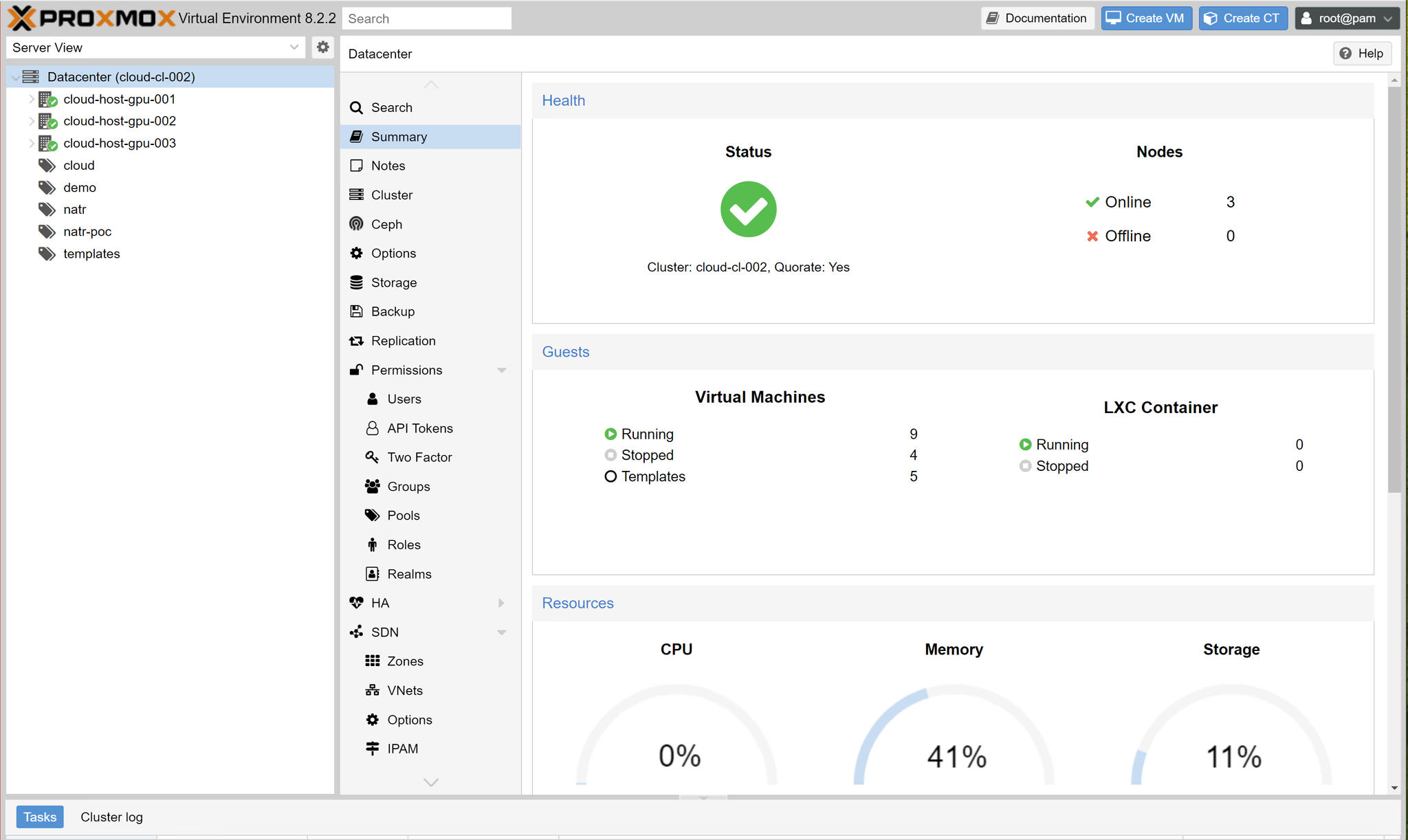
On this page
Behind the Scenes: How Natron powers its infrastructure with Proxmox
What is Proxmox?
Proxmox is an open-source software company which builds reliable infrastructure solutions.
Their main products are:
- Proxmox Virtual Environment (VE)
- Proxmox Backup Server
- Proxmox Mail Gateway
We at Natron use Proxmox VE and Proxmox Backup Server to deliver reliable infrastructure services to our customers.
Looking under the hood of Proxmox VE
Proxmox itself is a management layer, which combines a lot of open-source technologies to build a rock solid hypervisor with a lot of advanced featues. Those technologies include:
Debian: The default Proxmox installation is based on Debian. If you want, you can install Proxmox on an existing Debian/Ubuntu installation.
KVM (Kernel-based Virtual Machine): KVM turns Linux into a type-1 (bare-metal) hypervisor. It allows Proxmox to run multiple, isolated virtual machines by leveraging the power of the Linux kernel itself.
QEMU (Quick EMUlator): QEMU is a generic and open-source machine emulator and virtualizer, which Proxmox uses to achieve hardware virtualization.
Ceph and ZFS: For robust and scalable storage solutions, Proxmox integrates Ceph, a unified, distributed storage system designed for excellent performance, reliability, and scalability. The ZFS filesystem is known for its data integrity and ability to manage large volumes of data.
Corosync Cluster Engine: This component is designed for enabling high availability of clusters, managing cluster membership, and providing consistent data syncing across the network.
This is what the management webinterface looks like:

Rolling out VMs: A no-sweat approach
Deploying virtual machines (VMs) doesn't have to be a time consuming task filled with manual configurations and endless adjustments. Here at Natron, we have streamlined the process to make VM provisioning as smooth and straightforward as possible. Using Ansible in conjunction with predefined templates, we automated the steps needed to get a VM up and running quickly.
We do this using centrally defined workflows like:
🚀 Proxmox VM Setup:
- Clone Template
- Update VM Config (CPU, RAM, Storage, Cloud-Init)
- Boot VM
- […]
🔥 Firewall Rule Config:
- Create Firewall Aliases
- Append to Firewall Rules based on group membership
- […]
📦 Kubernetes Cluster Setup:
- Bootstrap Kubernetes Controlplane
- Join Worker Nodes
- Update Cycle of Kubernetes Clusters
- […]
Thanks to our standardized workflows, we can offer a wide range of services, including Kubernetes, S3 and various databases, with many more on the way. Our inventory is rapidly expanding to meet the evolving needs of our customers.
Keeping Proxmox in shape
For the maintenance of hypervisors, a key point is workload migration. Just like any other hypervisor, Proxmox allows you to live migrate VMs to a new host. During the live migration, all of the state (RAM) gets moved to a different host:
Just like any good hypervisor, Proxmox also allows you to bulk migrate all VMs as a single task.
A migration of 200 GBs of RAM currently takes us about 8 minutes (400 MB/s)
After all VMs are migrated, you can either update the host using the normal debian based linux commands:
Or you can use the web interface to do so. We at Natron leverage python based scripts to automate VM movement and the hypervisor maintenance process.
"Isn't Proxmox just for homelab users?"
Contrary to the perception that Proxmox is just for homelab users, our deployment at Natron Cloud shows its scalability and reliability in a larger environment. Proxmox VE's feature set and robust community support make it an ideal choice for powerful but still affortable virtualization solutions.
Because Proxmox offers a great API, a lot of tasks (templating, VM provisioning, maintenance, …) can be super easily automated. Proxmox runs on a native linux OS to which you get full access to configure and install your own customizations.
Proxmox offers Enterprise Support licenses using a simple and transparent licensing model. You can find more information here:
https://www.proxmox.com/en/proxmox-virtual-environment/pricing
Why we choose Proxmox
When it comes to managing our virtual infrastructure, choosing the right platform is crucial. After careful consideration, we opted for Proxmox VE (Virtual Environment) as our backbone for several compelling reasons. Here is why Proxmox stands out as the ideal solution for our needs:
Robust Technologies
- Integrates with proven solutions like KVM
- High reliability and stability
- Supports a wide range of hardware and software configurations
Good Automation
- Compatible with popular automation tools (e.g., Ansible, Packer, …)
- Allows for scripting and automatic scaling
- Simplifies repetitive tasks and bulk operations
Open Source
- Community-driven improvements
- Transparency and flexibility in customization
Flexibility
- Ceph software designed storage solution that allows HCI architecture
- Software defined networking (SDN) integrations

Sven Gerber
Cloud Engineer and Partner at Natron Tech, specializing in virtualization technologies and infrastructure automation.
“The right virtualization platform can transform how you manage infrastructure - Proxmox proves this every day.”
Read Next

Natron Cloud Upgrade - Building the Future of Our Infrastructure
How we upgraded our cloud infrastructure with new hardware, migrated workloads, and improved performance while maintaining sustainability
Jan 17, 2025

Kubernetes Training Success at Swisscom
How we helped 24 Swisscom employees master Kubernetes with hands-on learning
Jul 17, 2023